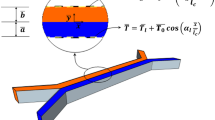Abstract
We derive semi-analytical solutions for solutal concentration distribution in microfluidic channels under the combined action of pressure-driven and electroosmotic transport, considering the effects of adsorption–desorption reactions at the substrate–fluid interface. Within the pertinence of common bio-microfluidic applications, we obtain the spatio-temporal evolution of analyte concentration by solving the corresponding eigen value problems on species transport with non self-adjoint operators, yielding non-orthogonal eigen functions. We analyze the implications of the relative strengths of the pressure-driven and electroosmotic flow components towards dictating the strongly interconnected reaction–advection–diffusion transport. We also discuss various interesting limiting cases, including the situations in which the solutal concentration band effectively propagates in the microchannel as a shock front. For such cases, we obtain the propagation velocity of the band as an explicit function of the relative strengths of the respective flow actuation mechanisms and the other significant parameters pertinent to the surface reactions.


Similar content being viewed by others
References
Abramowitz M, Stegun IA (1970) Handbook of mathematical functions. Dover, New York
Adey NB, Lei M, Howard MT, Jenson JD, Mayo DA, Butel DL, Coffin SC, Moyer TC, Hancock AM, Eisenhoffer GT, Dalley BK, Mcneely MR (2002) Gains in sensitivity with a device that mixes microarray hybridization solution in a 25-μm-thick chamber. Anal Chem 74:6413–6417
Benoit V, Steel A, Torres M, Lu YY, Yang HJ, Cooper J (2001) Evaluation of three-dimensional microchannel glass biochips for multiplexed nucleic acid fluorescence hybridization assays. Anal Chem 73:2412–2420
Cazes J, Scott RPW (2002) Chromatography theory. Marcel Dekker, New York
Das S, Das T, Chakraborty S (2006a) Modelling of coupled momentum, heat and solute transport during DNA hybridization in a microchannel in presence of electro-osmotic effects and axial pressure gradients. Microfluid Nanofluid 2:37–49
Das S, Das T, Chakraborty S (2006b) Analytical solutions for rate of DNA hybridization in a microchannel in presence of pressure-driven and electroosmotic flows. Sens Actuators B 114:957–963
Gervais T, Jensen KF (2006) Mass transport and surface reactions in microfluidic systems. Chem Eng Sci 61:1102–1121
Green R, Davies M, Roberts C, Tendler S (1999) Competitive protein adsorption as observed by surface plasmon resonance. Biomaterials 20:385–391
Grimes BA, Liapis AI (2001) Modeling and analysis of the electrokinetic mass transport and adsorption mechanisms of a charged adsorbate in capillary electrochromatography systems employing charged nonporous adsorbent particles. J Colloid Interface Sci 234:223–243
Hadd AG, Raymound DE, Halliwell JW, Jacobson SC, Ramsey JM (1997) Microchip device for performing enzyme assays. Anal Chem 69:3407–3412
Hunter RJ (1981) Zeta potential in colloidal science. Academic Press, New York
Kassegne SK, Reese H, Hodko D, Yang JM, Sarkar K, Smolko D, Swanson P, Raymond DE, Heller MJ, Madou MJ (2003) Numerical modeling of transport and accumulation of DNA on electronically active biochips. Sens Actuators B 94:81–98
Kim JH-S, Marafie A, Jia X-Y, Zoval JV, Madou MJ (2006) Characterization of DNA hybridization kinetics in a microfluidic flow channel. Sens Actuators B 113:281–289
Lu H, Koo LY, Wang WM, Lauffenburger DA, Griffith LG, Jensen KF (2004) Microfluidic shear devices for quantitative analysis of cell adhesion. Anal Chem 76:5257–5264
Mocanu D, Kolesnychenko A, Aarts S, Troost-Dejong A, Pierik A, Vossenaar E, Stapert H (2009) Mass transfer effects on DNA hybridization in a flow-through microarray. J Biotechnol 139:179–185
Patankar SV (1980) Numerical heat transfer and fluid flow. Hemisphere/McGrawHill, Washington
Rawool AS, Mitra SK (2006) Numerical simulation of electroosmotic effect in serpentine channels. Microfluid Nanofluid 2:261–269
Rawool AS, Mitra SK, Pharoah JG (2006) An investigation of convective transport in micro-PEM fuel cells. J Power Sources 162:985–991
Rhee HY, Aris R, Amundson NR (1989) First-order partial differential equations. Prentice Hall, New Jersey
Salimi Moosavi H, Tang T, Harrison DJ (1997) Electroosmotic pumping of organic solvents and reagents in microfabricated reactor chips. J Am Chem Soc 119:8716–8717
Telles AS, Queiroz EM, Filho GE (2001) Solutions of the extended Graetz problem. Int J Heat Mass Transf 44:471–483
Wang Y, Vaidya B, Farquar HD, Stryjewski W, Hammer RP, Mccarley RL, Soper SA (2003) Microarrays assembled in microfluidic chips fabricated from poly(methyl methacrylate) for the detection of low-abundant DNA mutations. Anal Chem 75:1130–1140
Woolley T, Hadley D, Landre P, deMello AJ, Mathies RA, Northrup MA (1996) Functional integration of PCR amplification and capillary electrophoresis in a microfabricated DNA analysis device. Anal Chem 68:4081–4086
Acknowledgments
The corresponding author gratefully acknowledges the financial support provided by the Department of Biotechnology, Govt. of India, for executing this research.
Author information
Authors and Affiliations
Corresponding author
Rights and permissions
About this article
Cite this article
Subramaniam, K., Chakraborty, S. A semi-analytical model for species transport in combined electroosmotic and pressure driven microflows with surface adsorption–desorption reactions. Microfluid Nanofluid 10, 821–829 (2011). https://doi.org/10.1007/s10404-010-0713-1
Received:
Accepted:
Published:
Issue Date:
DOI: https://doi.org/10.1007/s10404-010-0713-1




